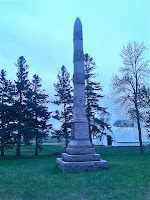 |
| Wood Lake Battlefield |
 |
| Wood Lake Monument Grounds |
 |
| Monument at Wood Lake |
The words, images, and landscape of the 1862 Maryland Campaign

 |
| Wood Lake Battlefield |
 |
| Wood Lake Monument Grounds |
 |
| Monument at Wood Lake |

Antietam 786
McClellan George B. 360
Maryland. 251
Jackson, Thomas J. 222
Lee, Robert E. 199
Stuart, James E.B. 166
South Mountain 142
Halleck, Henry 116
Hooker, Joseph 112
Hill, Daniel Harvey 101
Longstreet, James 70
Burnside, Ambrose 69
Pope, John 73
Richardson, Israel B. 56
Hill, Ambrose P. 52
Sumner, Edwin V. 42
Doubleday, Abner 41
Toombs, Robert 41
Pelham, John 38
Grant, U. S. 36
Meade, George 33
Franklin, William 32
Hood, John B. 24
Scott, Winfield 24
Reno, Jesse L. 20
Ewell, Richard 19
General 19
Miles, Dixon S. 19
Emancipation Proclamation 18
Gibbon, John 18
Iron Brigade 18
Sully, Alfred 18
Barton, Clara 16
Crook, George 15
Sedgwick, John 15
Pendleton, William N. 14
Porter, Fitz John 14
Mansfield, Joseph K. F. 13
Stanton, Edwin 13
Howard Oliver O. 12
Davis, Jefferson 9
Gordon, John 9
Pleasonton, Alfred 9
Gregg, Maxcy 8
Rodes, Robert E. 8
Warren, Gouverneur 8
Cobb, Howell 7
Dana, Napoleon J.T. 7
Hampton, Wade 7
Hayes, Rutherford B. 7
Sherman, William T. 7
Anderson, Robert 6
Barlow, Francis 6
Evans, Nathan G. 6
Garland, Samuel 6
Lee, Fitzhugh 6
McDowell, Irvin 6
McLaws, Lafayette 6
Newton, John 6
Semmes, Paul 6
Alexander, Porter 5
Davis, Benjamin F. 5
Douglas, Henry Kyd 5
Early, Jubal 5
French, William 5
Gettysburg 5
Gorman, Willis A. 5
Jones, David R. 5
Jones, William E. (Grumble) 5
Patrick, Marsena 5
Pender, Dorsey 5
Ripley, Roswell S. 5
Sheridan, Philip 5
Thomas, George 5
Wainwright, Charles S. 5
Banks, Nathaniel 4
Beauregard, P. G. T. 4
Cox, Jacob 4
Haskell, Frank 4
Heintzelman, Samuel P. 4
Jones, David R. 4
Meigs, Montgomery 4
Robertson, Beverly 4
Rosser, Thomas 4
Taylor, Zachary 4
Williams, Alpheus 4
Winder, Charles S. 4
Anderson, Richard 3
Branch, Lawrence O. B. 3
Buford, John 3
Butler, Benjamin 3
Cleburne, Patrick R. 3
Couch, Darius 3
Crawford, Samuel 3
Cross, Edward 3
Custer, George 3
Garnett, Richard B. 3
Kearny, Philip 3
Kimball, Nathan 3
Magruder, John 3
Mahan, Dennis Hart 3
Mexican War 3
Pry, Phillip 3
Roulette, William 3
Tew, Courtenay 3
Tidball, John C. 3
Trimble, Isaac R. 3
Wadsworth, James S. 3
Benning, Henry 2
Buell, Don Carlos 2
Butterfield, Daniel 2
Cooke, Philip St. George 2
First Minnesota 2
Fremont, John 2
Hancock, Winfield Scott 2
Heth, Henry 2
Holmes, William R. 2
Hunt, Henry 2
Hunter, David 2
Ingalls, Rufus 2
Iverson, Alfred 2
Jenkins, Micah 2
Johnson, Edward 2
Kingsbury, Henry W. 2
Lawton, Alexander 2
Lee, Rooney 2
Mumma, Samuel 2
Otto, John 2
Pemberton, John 2
Pickett, George 2
Pillow, Gideon 2
Poffenberger, Joseph 2
Reno, Marcus 2
Sherrill, Eliakim 2
Sigel, Franz 2
Taylor, Richard 2
Twiggs, David 2
Von Borke, Heros 2
Webb, Alexander 2
Wheeler, Joseph 2
Ames, Adelbert 1
Anderson, George B. 1
Bachelle, Werner 1
Barksdale, William 1
Beach, Francis 1
Bee, Barnard 1
Bragg, Edward S. 1
Birney, David 1
Breathed, James 1
Brooks, William T. H. 1
Buchanan, James 1
Cake, Henry 1
Chancellorsville 1
Chew, Preston 1
Colquitt, Alfred 1
Cothran, George W. 1
Croasdale, Samuel 1
Crome, George 1
Cutler, Lysander 1
Dabney, Robert Lewis 1
Dahlgren, John 1
Drayton, Thomas F. 1
Duryee, Abram 1
Featherston, Winfield Scott 1
Floyd, John B. 1
Fox, Gustava Vasa 1
Gallagher, Thomas F. 1
Garnett, Robert 1
Gladstone, William 1
Gorgas, Josiah 1
Greene, George S. 1
Griffin, Charles 1
Harney, William 1
Hawkins, Rush 1
Henry, Mathis W. 1
Houston, Sam 1
Jackson, Andrew 1
Jones, John R. 1
Kershaw, Joseph B. 1
Keyes, Erasmus 1
Kilpatrick, Judson 1
Letterman, Jonathan 1
Loring, William W. 1
Mahan, Alfred T. 1
Mahone, William 1
McClellan, Henry 1
McRae, Duncan 1
Milroy, Robert 1
Miller, D. R. 1
Mosby, John S. 1
Mott, Gershom 1
Munford, Thomas 1
Napoleon III 1
Newcomer, Joshua 1
Nisbet, Reuben B. 1
Parham, William Allen 1
Parker, Francis Marion 1
Parks, Joseph 1
Pinkerton, Allen 1
Piper, Henry 1
Poffenberger, Alfred 1
Polk, Leonidas 1
Reynolds, John 1
Rosecrans, William 1
Seddon, James 1
Seymour, Truman 1
Scammon, Eliakim 1
Sherrick, Jospeh 1
Shields, James 1
Smith, Gustavus W. 1
Smith, Persifor 1
Sorrell, G. Moxley 1
South Mountain 1
Steuart, George H. 1
Sturgis, Samuel D. 1
Sumner, Charles 1
Thompson, James 1
Torbert, Alfred 1
D'Utassy, Frederick G. 1
Walker, John 1
Wellesley, Arthur 1
Welsh, Thomas 1
White, Julius 1
Wilcox, Orlando 1
Wistar, Isaac J. 1
Wright, A. R. "Rans" 1
No comments:
Post a Comment